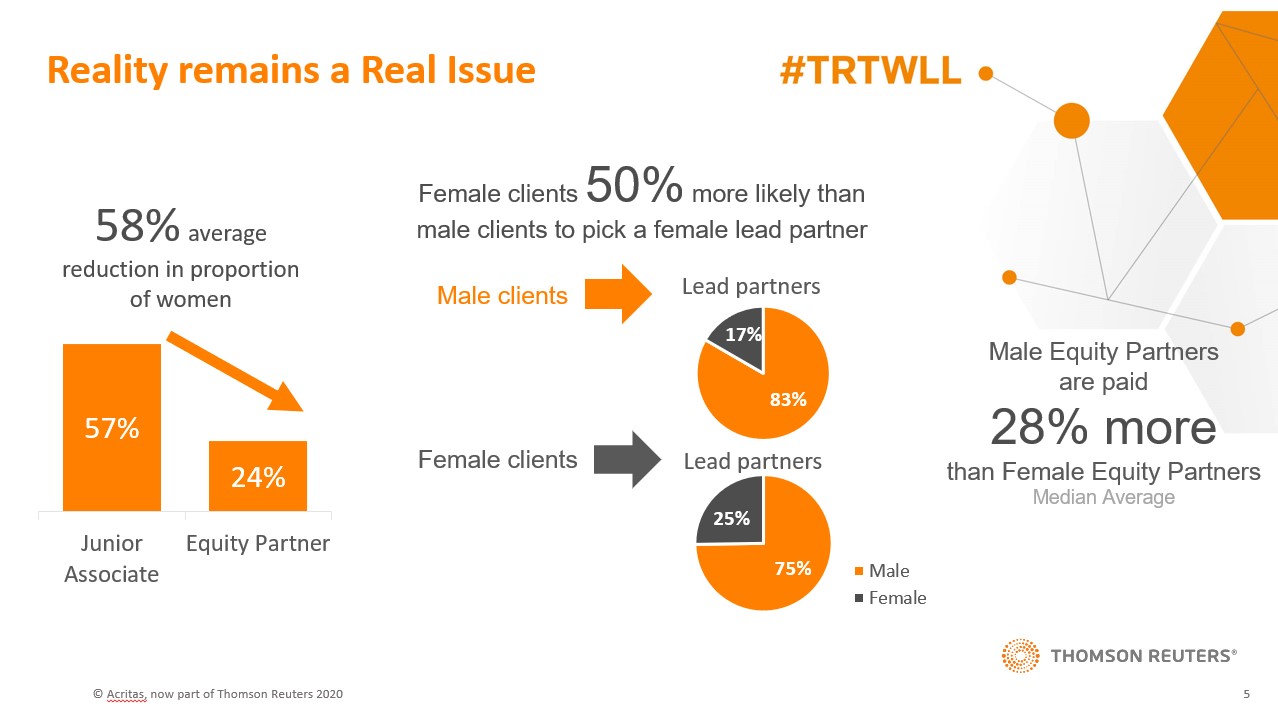REUTERS/Ivan Alvarado (Photo)
Despite huge efforts to achieve greater diversity, equity and inclusion (DEI) within the legal sector, the statistics show that progress remains stubbornly stuck. We can only really move forward, if we shift gears to redefine and approach DEI as part of a programme of strategic business transformation.
These reflections and findings from a recent Transforming Women’s Leadership in Law (TWLL) panel webinar have been summarised here by the panel chair, Julia Hayhoe, a TWLL Advisory Board Member. They include insights from both the panellists and an audience drawn from across the legal sector.
Panellists:
- Sarah Hemsley, General Counsel and Company Secretary, Selfridges
- Daniel Danso, Global Diversity Manager, Linklaters
- Simon Zinger, General Counsel, Dentsu Aegis Network
Progress Remains Stubbornly Stuck
The panel began by acknowledging the legal industry context—namely that despite much energy, effort, and activity within the sector to achieve tangible change with DEI, enough progress has not been made.
As a result:
- social and individual human inequalities remain insufficiently tackled;
- much business value creation is either being squandered or remains untapped; and,
- significant risks are left unseen or unaddressed.
The reality and norms we live within the legal sector is a real issue, as the data points in the chart below so clearly illustrate.

This is an issue we see in wider business and not just in the legal industry, of course.
Whilst there are now more women represented on corporate boards, the proportion of women CEOs remains at just 5 percent in FTSE100 companies and at 2 percent in the FTSE250. The recent McKinsey Women in the Workplace 2020 report drew attention—not just to women being held back by the ‘glass ceiling’, but also spoke of the ‘broken rung’ lower down the ladder, with just 38 percent of first management positions going to women. The report also highlighted how COVID-19 has had a disproportionately negative impact on working women and minorities.
All these issues resound loudly through the legal sector.
So how can we achieve real change?
Harness the positive winds of change
On the positive side, the panel members recognised that the legal sector has been galvanised by the ‘Gender Equality’ and ‘Black Lives Matter’ movements, bringing renewed focus on DEI. We strongly believe there is a chance to harness these positive winds of change.
There are three areas in particular that leaders need to focus and take action:
- Leadership teams are now increasingly engaged and recognise that the key to material change is to ensure that DEI forms an integral part of systemic business transformation. There is encouraging evidence that business is increasingly incorporating DEI within sustainability and specifically within the social and governance aspects of ESG (environment, social, and corporate governance) in their business strategy, rather than as stand-alone programs. And this is set against a favourable macro backdrop, where many businesses are undertaking a fundamental reappraisal of their purpose in society and thinking about what their brand really stands for today.
“We are seeing a fundamental reappraisal of what a business and its brand stands for.” Daniel Danso
“Sustainability and diversity have to be intertwined.” Sarah Hemsley
2. Demand for change, empowered by social media, is coming from a broad range of stakeholders—customers/clients, employees, investors and communities. This is creating a multiplier effect that is being felt acutely by senior leaders in law firms, in-house legal teams, at the Bar, and among industry regulators. Understanding this new and much wider stakeholder landscape, and in particular, seeking out and trying to understand all the voices in this debate, is key to achieving change. The General Counsel Oath developed by Simon Zinger, is a good example of the tangible commitments and actions we are seeing. It clearly describes the pivotal role General Counsel’s (GCs) can play, harnessing their privileged position, and power to accelerate progress.
“General Counsel and law firm partners are increasingly seeing themselves as business leaders, with a key role to play in getting the board ahead of the curve in meeting this widespread stakeholder demand for change.” Simon Zinger
“It’s key to channel the energy that is coming from this time… from the customer… the creative Black voices and local talent.” Sarah Hemsley
3. There is increasing mainstream awareness of the significance of Intersectionality, that is, an understanding of how different inequalities—whether based on gender, race, class, sexual orientation or physical ability—interconnect to multiply the marginalising effects of discrimination and oppression. Without addressing DEI issues with an intersectional lens, work to tackle discrimination and injustice towards women, for example, is in danger of leaving other related inequality hurdles unaddressed. Here we urge leaders to listen and learn about Intersectionality and be conscious that their privileged position brings both great opportunity and responsibility to think and act in more savvy and strategic ways.
“Social mobility is often an underlying issue across minorities, inhibiting access to the profession. Selfridges’ legal apprenticeship scheme seeks to address this.” Sarah Hemsley
“Business is becoming savvier and now thinking about Intersectionality and what it means for the business. For example, you can see a woman though a variety of different spectrums and still focus on gender.” Daniel Danso
Consciously guard against new hurdles
Whilst the three areas above give hope that progress can be made, new challenges are being uncovered all the time. There is a particular need to guard against un-intended consequences. The top three leadership challenges considered of significance are:
- Exponential demands from the client—for law firms to field diverse and inclusive teams and to allocate work to their people on that same equitable basis. Whilst welcomed as a call to action, it does place an, at times, overwhelming demand on law firms and, in some cases, is straining the very minority talent pools that the call is designed to empower. In response, the key here is not simply to react in an ad hoc way. Instead, leaders need to think and act strategically, as some firms are now doing. To address this issue Linklaters has, as one example, launched its Diversity Faculty to collaborate in a more strategic and longer-term way with clients. This includes bringing the firm’s and the client’s diversity and inclusion experts together to collaborate on education, training and, ultimately, to enable systemic change.
“All of a sudden every client is wanting to partner at the same time with the same groups in the same way.” Daniel Danso
“The key is for GCs and firms to work in collaboration together.” Simon Zinger
- There are similar levels of exponential demand, largely from white colleagues, to talk about race. Again, welcomed when framed as a call to learning and action, this can place overwhelming demands on BAME (Black, Asian, and Ethnic Minority) communities to have conversations that are not new in their own experience. The panel members have heard that people also often feel anxious and worried talking about gender, race, and wider minority issues. Yet without these conversations, we know that there is an increased risk of stereotyping, of assumptions being made, and of fears becoming entrenched.
“We need to focus on building up trust and psychological safety to have these conversations.” Sarah Hemsley
“There isn’t a laundry list of words or behaviours that will always be right, because people are people, and it is better to understand the diversity of that particular person.” Daniel Danso
As different aspects of DEI increase in profile, we heard of two worrying developments—that some businesses are confused about what to prioritise, and, worse still, that competition is developing between the different strands within DEI. Antidotes to this lie in approaching each element as within the wider equality movement, making DEI as part of a whole business strategy and through building institutional allyship. Ultimately the key is to do the work to understand the particular root cause issues within a business, and in working out how best to collaborate on the cultural and behavioural change that is required, as part of an overall business strategy.
“We need to come together to provide allyship for each other. We can do so much more together, than we can as segregated and silent.” Daniel Danso
Redefine and approach DEI as a strategic business transformation
Transitions are often defined by a period of ending and letting go, before you can embrace the new, with an in-between phase—the Neutral Zone—as seminally described by William Bridges. This in-between phase is a messy and disorienting time, where the risk of becoming stuck is most acute.
The panel concluded that, to get unstuck, leaders—in both the legal sector and beyond—need to embrace DEI as an issue that is fundamental to strategic business transformation.
That means DEI needs to be incorporated within the business strategy, with a bold vision, effective governance and broad stakeholder collaboration, evolving behaviours and culture, and supported by robust and tangible metrics and milestones.

Julia Hayhoe, former Global Chief Strategy Officer and Global Executive Committee Member at Baker McKenzie, now leads Hayhoe Consulting advising legal and other professional service businesses on how to achieve strategic sustainable growth for themselves and for their clients.



